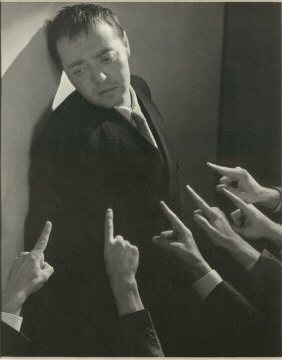I wonder how the students take it when I say things like "everybody back then was a Commie." Do they know what that means? What that would have meant culturally twenty years ago? Eighty years ago?

Brecht's thinking, which we'll sum up as "verfremdungseffekt" in order to incorporate the three major parts of his philosophy (story structure, production/direction, performance) has particular resonance for animators.
I'll write more exhaustively about this in future.
For now, a brief bit: one student asked what "man as changeable" meant. I explained with two example from Brecht's work.
The clearer is the scene from "Life of Galileo" (with Charles Laughton as collaborator) in which Barberini, originally Galileo's defender, becomes convinced that he must be arrested. Throughout the scene Barberini is being outfitted as Pope, when the final piece of costume is placed his resolution is firm.
The other scene is from "Mann ist Mann". Gaily Gay gives his own eulogy, convinced that the he is someone else. This was a part originally played by Peter Lorre.
"You all know Peter Lorre, right?" Of course not.
Coincidentally, this class was on the same day as John Canemaker's Chuck Jones documentary kicked off an evening of classic animation on TCM.
Unfortunately, the Jones' directed "Hair-Raising Hare" was not part of the bill.
Here's a Steve Brodner Peter Lorre which is an outtake from "The Naked Campaign"
 we were comparing candidate Guiliani to Peter Lorre starring in the Brady Bunch
we were comparing candidate Guiliani to Peter Lorre starring in the Brady Bunch
looking for a video clip from "Hare-Raising Hare" I found this:
Peter Lorre on "What's My Line?" pimping "Scent of Mystery" in Odorama.
Fascists drove him from his homeland, Hollywood drove him to the needle.
Here's a poem Brecht wrote after Lorre and his struggle to make it in Hollywood:
"The Swamp"I saw many friends
And the friend I loved most
Among them helplessly sunk
Into the swamp.
I pass by daily.
And a drowning was not over in a single morning.
This made it more terrible.
And the memory of our long talks about the swamp
Which already held so many powerless.
Now I watched him leaning back
Covered with leeches in the shimmering,
softly moving slime
Upon the sinking face
The ghastly blissful smile.
"Scent of Mystery" also has a mark in animation history.
The opening short was also in Odorama. "Old Whiff", directed by John Hubley. Ed Smith told me he did some animation on it, according to Michael Sporn, Tissa David said she and Grim Natwick worked on it as well. This may have been one Tissa's first jobs at Hubley, production would have been in 1959/60. They had just finished "Terror Faces Magoo" at UPA. Tissa didn't animate for Hubley until later in the 60s (that's another anecdote) and Natwick isn't credited on any of his independent films (to my knowledge). They did do commercials with Hubley all during the 60s, though. And obviously, John and Grim had a long working relationship prior.
This film is no longer extant.A few years back I emailed F. Gwynplaine MacIntyre who posted an online review. "Where did you see it?" I asked.
He's an extraordinarily friendly chap with mighty, mighty facial hair. (order his book) He had seen it in the private screening room of (Lord) Lew Grade. I believe the British impresario had purchased at least part of the Todd A-O company (inventors of Odorama), although I can't find anything online to confirm that.
In any event, that's the last known location of this Holy Grail. Lew Grade died in 1998. His nephew, Michael Grade, was his primary heir. Presumably, and hopefully, Hubley's film and scratch and sniff cards are safely locked in a secret vault deep below Buckingham Palace.
I did make a half-hearted effort to contact Sir Grade but forgot about it after two or three days.

2 comments:
Back then, they did not use scratch and sniff cards." An odor was sent into the theater's air. I don't quite know how they cleared the air for the next odor, but this is how it worked. I believe John Waters' film Polyester (1981) was the first to use scratch and sniff cards.
I remember you saying things like that in class, and half the class not responding. Your class was one of the best ones I had at Parsons.
Post a Comment